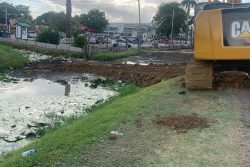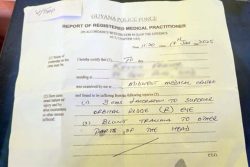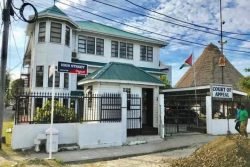With expected above normal rainfall likely to cause flooding in low lying areas, the Civil Defence Commission (CDC) has called on Regional Democratic Councils (RDCs) to activate their Regional Emergency Operation Centres (REMS) in preparation.
Several hundred persons in coastal communities have already been affected after the continuous rainfall on Monday left their homes waterlogged and efforts are underway to provide them with relief.
CDC Director-General Lieutenant Colonel Kester Craig yesterday told the Department of Public Information (DPI) that based on reports from the Ministry of Agriculture’s Hydrometeorological Service, Guyana is expected to receive above normal rainfall and low-lying areas could experience flooding. Although the CDC will continue to monitor the expected rainfall, Craig was reported as saying by DPI that RDCs should activate their multi-agency response mechanisms since the Commission needs their support. “The CDC is prepared to work with all the Regional Democratic Council to provide technical guidance to ensure effectiveness and efficiency,” he was quoted as saying.
The Hydrometeorological Department on Monday announced the start of the rainy season, while saying that chances of flooding between now and January have increased due to a “moderate” La Nina weather pattern. It also stated that there are increased chances of flooding in regions 1, 2, 3, 4, 5, 6, 7, 8, and 10 from November to January, 2021.
The anticipated rainfall is forecast to be around 25mm over regions 1 to 6, and 10, and 15mm to 30mm elsewhere. An above normal high tides advisory is also still in effect.
Craig also called on Neighbourhood Democratic Councils (NDCs) to lend support to RDCs. “The emergency response mechanism, from national right down to the community level, it is important that we activate it and be on standby to respond and alleviate the impact of flood across the country,” he said, while also urging that citizens play their part by ensuring that they have proper drainage.
Hardest hit
Due to continuous rainfall, the CDC on Monday deployed assessment teams to gauge the impact of the weather on public and private infrastructure. In Region Four, it said, the hardest hit villages were Mon Repos North (35 households), Good Hope (140 households), Annandale North (140 households), and Goedverwagting (8 households) along the East Coast of Demerara.
Additionally, in Region Ten, the CDC said that up to yesterday the hardest hit households were in Wismar (Alley One, Two and Three), with some 360 residents affected, according to Regional Chairman of Region Ten Derron Adams. Of that number, it added, 180 of those persons were still flooded.
In Region Five, De Edward Village (13 households) and Rosignol Village (75 households) were described as hardest hit while further assessments were set to commence at Bath Settlement.
The CDC distributed cleaning and sanitising hampers to affected households.
Meanwhile, meanwhile, the DPI said Agriculture Minister Zulfikar Mustapha and a team from the National Drainage and Irrigation Authority (NDIA) and the Guyana Sugar Corporation (GuySuCo) conducted flood assessments in several areas along the East Coast Demerara corridor.
At Montrose, three of the five pumps operated by GuySuCo were found to be inoperable. However, this was swiftly remedied.
“We have put in, from the NDIA level, additional pumps. At Montrose, we will have four pumps operable there. At Triumph, we have an additional pump and those pumps that we have at Good Hope, the NDIA has in operation the last 24 hours to drain the area. As a result, we are here now and there is no water on people’s land,” Mustapha said.
The report said he also instructed the NDIA to ensure emergency work is done to ensure that the main drainage channel in the area is cleaned and it noted that machines were being deployed to clean drains in the Triumph/Mon Repos area.
Like Craig, Mustapha also highlighted that citizens have a part to play in ensuring that there is proper drainage by refraining from littering the waterways.
“I want to also sound the warning to residents that we should desist from throwing garbage in these drainage canals. At Good Hope last night, a lot of garbage came out the canal and that was blocking the flow of water,” he said.
“…The residents also have to make sure that they take care of the drainage system; not block the drainage system, not to interfere with NDIA systems in the area, nor put down structures that will impede the flow of water,” he added.
Anyone wishing to report flooding can call the 24-hour National Emergency Monitoring System (NEMS) on 623-1700, 600-7500, or 226-1114.










